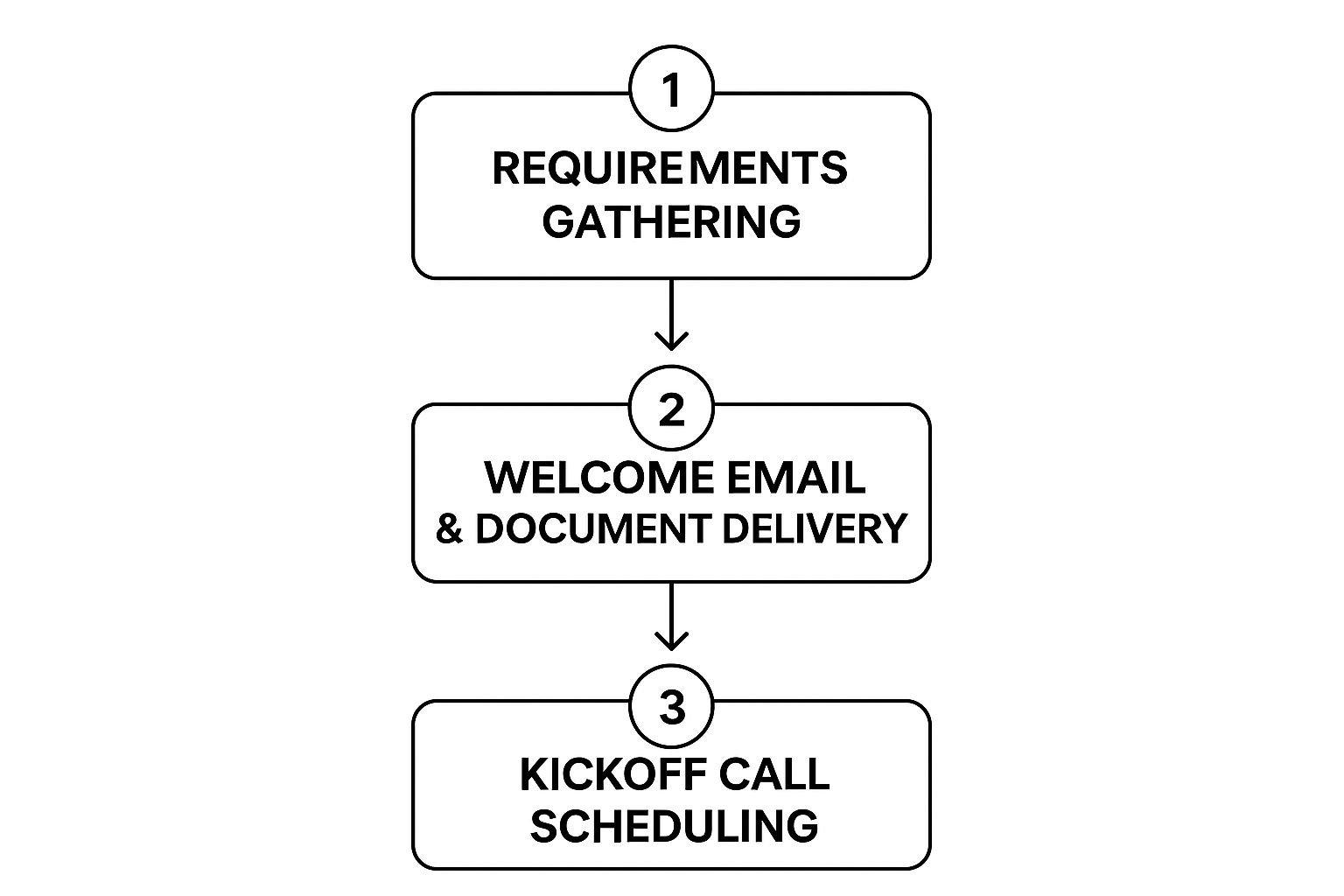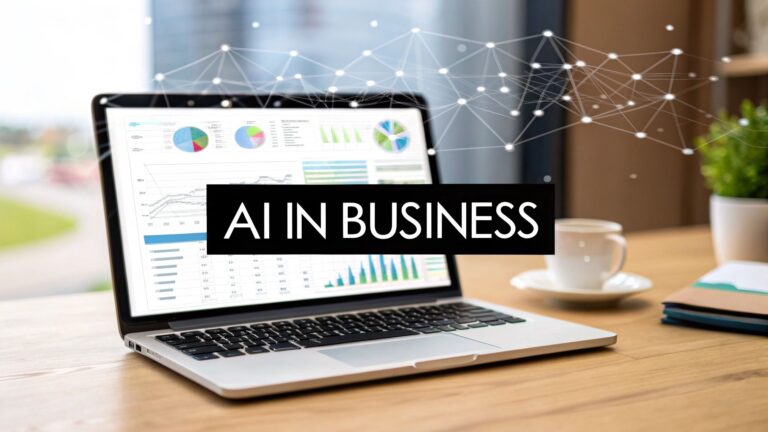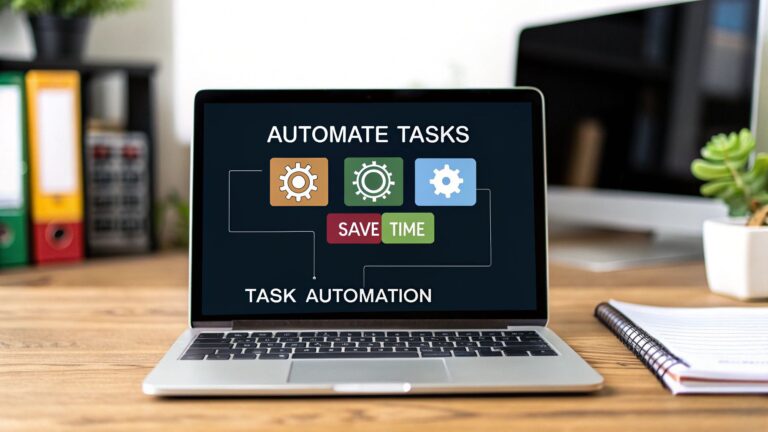Client Onboarding Process Template | Streamline Success
A great client onboarding template isn't just a checklist; it's your playbook for turning a brand-new customer into a long-term, raving fan. Think of it as a repeatable, structured roadmap that takes a client from the moment they sign on the dotted line to the point where they're fully up and running and genuinely seeing the value in what you do. This framework is what ensures nothing falls through the cracks. It’s how you build trust right away and lay the groundwork for a profitable, lasting partnership.
Why Your Onboarding Process Is Losing You Clients

That initial 90-day window with a new client isn't just some honeymoon phase—it's the foundation of your entire relationship. A clunky or non-existent onboarding process is more than a minor annoyance; it’s a surefire way to push good clients out the door before you’ve even had a chance to prove your worth.
When clients sign up, they're excited and hopeful. A disorganized, confusing onboarding experience shatters that optimism almost instantly. It creates friction, plants seeds of doubt, and makes them wonder if they made the right choice in hiring you.
The Real Cost of a Bad First Impression
The fallout from poor onboarding is serious and expensive, going far beyond just one unhappy customer. A bad start triggers a predictable and damaging domino effect that can ripple through your entire business.
The most immediate consequence is early client churn. When a new client feels neglected or confused in those first few weeks, they disengage. Their initial excitement sours into buyer's remorse, and they start looking for the exit before the relationship can even get off the ground.
Another huge problem is a damaged brand reputation. An unhappy client rarely leaves quietly. Their negative experience becomes a cautionary tale they share with their network, which can cost you referrals and tarnish your credibility in the industry.
A weak onboarding process is the single fastest way to lose a client's trust. It signals disorganization and a lack of care, setting a negative tone that is almost impossible to recover from.
This initial friction also breeds scope creep and endless questions. Without clear guidelines and managed expectations from day one, clients are left to guess. This leads to constant, time-wasting back-and-forth and a frustrated team trying to manage a relationship that has no clear structure.
The Power of a Structured Welcome
On the flip side, a well-planned onboarding process built from a solid template does more than just prevent problems—it actively creates value. It’s your first and best chance to prove you’re competent, professional, and genuinely invested in your client's success. This positive first impression is directly tied to several key business outcomes.
- Higher Client Retention: A smooth start makes clients feel confident and supported, dramatically increasing the odds they’ll stick with you for the long haul.
- Increased Lifetime Value: Happy, engaged clients are far more likely to upgrade their services, buy add-ons, and grow their business alongside yours.
- A Stream of Referral Business: Clients who have an amazing onboarding experience become your best salespeople, eagerly sending new business your way.
The numbers don't lie. Those first few weeks are absolutely critical. One study found that a shocking 75% of customers abandon a product within the first week if the initial phase is a struggle. To keep your own process from losing clients, understanding key customer onboarding best practices is essential.
Even better, research shows that improving retention by just 5% can increase profits by anywhere from 25% to 95%. A great client onboarding template isn't just an administrative nice-to-have; it's a strategic asset for growth.
Building the Core of Your Onboarding Template
Once the contract is signed, the real work begins. This is where you build the foundation for a lasting, successful partnership. A solid client onboarding template isn't just a list of tasks; it’s your playbook for turning a new client’s initial excitement into genuine, long-term trust. It ensures every client gets the same high-quality, professional experience, right from day one.
The process actually starts before your client is even aware of it. I call this the pre-kickoff phase, and it’s all about internal preparation. This is your team’s time to get its ducks in a row. You'll gather the signed contract, the scope of work, and any crucial notes from the sales calls. Then, you set the client up in your project management software, create the shared drives, and provision access to any necessary tools. Getting this done behind the scenes means you walk into that first official meeting looking composed and prepared, not scrambling.
This initial, structured flow is what separates a smooth start from a chaotic one.

As the visual shows, a powerful kickoff meeting is the direct result of methodical preparation, not just a time slot on a calendar.
To help map this out, I've broken down the key phases of onboarding and what you should be trying to achieve in each one.
Onboarding Phases and Key Objectives
Here's a look at the typical stages of a well-structured onboarding process. Each phase has a distinct purpose that builds upon the last, moving the relationship from administrative setup to strategic partnership.
| Onboarding Phase | Primary Objective | Key Activities |
|---|---|---|
| Pre-Kickoff | Internal Alignment & Preparation | Gather documents, set up project management tools, create shared folders. |
| Kickoff Meeting | Establish Trust & Set Expectations | Introduce team roles, align on goals, review scope and timeline, define communication. |
| Initial Setup | Empowerment & Resource Provisioning | Send welcome kit, grant system access, schedule initial follow-ups. |
| First Value Delivery | Demonstrate Competency & ROI | Complete a first tangible task (e.g., audit, technical setup, strategy draft). |
| Ongoing Engagement | Maintain Momentum & Build Habits | Establish regular check-ins, provide proactive updates, solicit early feedback. |
Thinking about onboarding in these distinct phases helps ensure you're not just completing tasks, but actively guiding the client toward a successful long-term relationship.
Designing the Kickoff Meeting
The kickoff meeting is the formal launch of your partnership. It's your single best chance to set the tone, establish your authority, and manage expectations from the get-go. An unstructured meeting will almost always lead to a messy, undefined partnership. Your template needs a standardized—yet flexible—agenda for this critical touchpoint.
A high-impact kickoff agenda should always cover:
- Team Introductions: Don't just list names and titles. Explain why each person is on the project and how they'll specifically help the client. This builds an immediate human connection.
- Goal Alignment: Start by restating the client's main objectives. This simple act shows you were listening during the sales process and centers the entire project on their definition of success.
- Scope & Timeline Review: Walk through the key deliverables and high-level milestones. This isn't the time for granular details, but for confirming everyone agrees on the big picture.
- Communication Cadence: Be crystal clear about how you'll communicate. Is it a weekly email report? Bi-weekly calls? A dedicated Slack channel? Nailing this down now prevents a world of frustration later.
The real goal of the kickoff isn’t just to start the project; it’s to build confidence. A client should leave that meeting feeling completely reassured they made the right choice and knowing exactly what happens next.
Assembling the Welcome Kit
Right after a great kickoff meeting, you need to capitalize on that momentum. Send a comprehensive welcome kit. Think of this as a curated package of resources that empowers your new client and reinforces everything you just discussed. A digital version is incredibly efficient and easy to update.
Your welcome kit should include:
- A Kickoff Summary: A quick recap of key decisions, action items, and the immediate next steps.
- Contact Information: A simple cheat sheet of who to contact for what—billing, technical issues, project questions, etc.
- Tool & Platform Links: Direct links to any software, portals, or shared drives they'll need, along with login details.
- Onboarding Schedule: A simplified timeline showing the next 30-60 days so they have a clear view of upcoming progress.
Taking this proactive step nearly eliminates the "What's next?" and "Where do I find…?" emails that can swamp the first few weeks of a project. To make sure your template is built on a solid foundation, it's worth exploring these customer onboarding best practices.
Delivering the First Piece of Value
Finally, the core of your template has to drive toward a quick win. The planning is over; it's time to deliver something tangible. This first victory proves your competence and shows an immediate return on their investment.
This could be anything from completing the full technical setup, delivering a first-round audit, or presenting a detailed strategy outline. It’s the moment the relationship shifts from promises made to promises kept.
Of course, no process is ever perfect. You should always be looking for ways to improve. For a deeper dive into optimizing your own workflows, our guide on https://makeautomation.co/business-process-improvement-methods/ offers some excellent frameworks. By building these core components into your onboarding template, you create a reliable, scalable system for kicking off every single client relationship on the right foot.
Crafting a Personalized Onboarding Experience

If you treat every new client the same, you're going to get the same generic results. A one-size-fits-all onboarding process is a huge missed opportunity to show a client you actually get them and their unique world. The real goal isn't just to tick boxes on a checklist; it's to create a journey that makes each client feel seen and understood from day one.
This all starts with gathering better information right out of the gate. Your sales team likely uncovered the client's main problems, but onboarding is where you dig into the details. This is your chance to understand their team dynamics, their internal politics, and what success really looks like to them. It’s the moment you stop being just another vendor and start becoming a true partner.
Using Surveys and Calls for Deeper Insights
Your first discovery call and a thoughtfully designed welcome survey are your best friends here. Don't squander this chance with basic, surface-level questions. You need to ask things that give you real, actionable intelligence you can use to shape the entire relationship.
For instance, instead of the vague, "What are your goals?" try getting more specific:
- What would be a huge 'win' for your team in the first 30 days of us working together?
- Who is the final decision-maker for approvals? And who's the best person for quick, day-to-day technical questions?
- Is there anything you've experienced with other agencies that you absolutely want to avoid this time around?
Questions like these give you a clear map of their expectations and potential landmines. Imagine you're a digital marketing agency and you discover your new e-commerce client has a massive product launch in six weeks. Boom. You can immediately pivot the onboarding to prioritize campaign setup, delivering tangible value right where they need it most.
The data backs this up. Around 63% of customers say the onboarding experience is a major factor in their decision to stick with a business. And the pressure is on to be responsive—a staggering 80% of B2B clients expect real-time engagement. If you want to dive deeper, you can explore more customer onboarding statistics and trends to see just how high the stakes are.
Weaving in Personalized Touches
Once you have these little nuggets of gold, you have to actually use them. Personalization can be threaded throughout your client onboarding process in ways both big and small. These are the thoughtful actions that prove you're paying attention and care about more than just the invoice.
One of the easiest wins? A personalized welcome video. Ditch the generic automated email and have the account manager record a quick, informal video. Just a simple "Hello," mentioning a specific goal the client shared, and expressing genuine excitement is all it takes. This small effort makes your company feel human from the get-go.
Another great move is to customize the resources you share. If your new client is in the healthcare space, don't send them generic business articles. Send them case studies from other healthcare clients you’ve helped. Share articles about industry-specific compliance challenges you know how to navigate. Show them you've done this before.
A personalized onboarding process doesn't just feel better for the client; it strategically aligns your actions with their most pressing needs, accelerating their time-to-value and building unshakable trust.
When you make the experience collaborative and build your milestones around their definition of success, you turn a routine procedure into a powerful engine for building relationships. This is how you get clients who not only stick around but also become your biggest fans.
Automating Workflows Without Losing the Human Touch
As your business grows, you eventually hit a wall. You simply can't handle every single onboarding task by hand anymore. That’s a good problem to have, but it means you have to get smart about efficiency. The trick is scaling your client onboarding without sacrificing the genuine human connection that got you here in the first place.
This isn't about replacing your team with robots. It's about empowering them. The real goal is to free your people from the grind of repetitive tasks so they can focus on what they do best: building rock-solid client relationships.
Think of automation as a brilliant assistant, not a replacement. When you automate the right things, you create more time and headspace for the high-value, strategic work that builds unshakeable client trust. A well-designed client onboarding process template is your guide to striking this perfect balance.
What to Automate for Maximum Efficiency
Certain parts of the onboarding journey are just begging to be automated. I'm talking about the low-touch, repetitive tasks that are crucial for momentum but don't need a personal conversation to get done. Automating these not only saves time but also slashes the risk of human error and keeps the experience consistent for every single client.
A perfect example is the first welcome email. The second a contract is signed, an automated workflow can fire off an email that confirms the partnership, outlines what's next, and links to their welcome kit. The client gets instant confirmation and feels taken care of, and your team doesn't have to live in their inbox.
Here are some of the best candidates for workflow automation I've seen work wonders:
- Internal Handoffs: Automatically create a new channel in Slack or Microsoft Teams and ping the project team the moment a deal closes.
- Project Setup: Use a tool like Zapier or Make to instantly create a new project in Asana or Trello from a pre-built template, complete with all the standard first-phase tasks and deadlines.
- Document Delivery: After the kickoff call, automatically send out key documents like the welcome packet, a detailed questionnaire, or the service level agreement (SLA).
- Scheduling Follow-ups: Instead of the endless "what time works for you?" email chain, just drop a Calendly or SavvyCal link into your automated follow-up sequences.
If you want to go even deeper on the tech that makes this possible, this AI-powered workflow automation explainer guide is a great resource for understanding the systems behind the scenes.
Where the Human Touch is Non-Negotiable
While your automations are handling the logistics in the background, the most important moments in onboarding absolutely require a real person. These are the interactions that build rapport and make a client feel seen, heard, and valued. No amount of code can fake the impact of a genuine conversation or a thoughtful, unscripted check-in.
The rule of thumb is simple: automate the transactional, but personalize the relational. Your onboarding template should be a map that clearly shows where your team needs to show up personally.
The project kickoff call is the classic example. This meeting is your single best shot at building chemistry, aligning on goals, and answering nuanced questions face-to-face. Trying to automate this would be a disaster; it sets the entire tone for the relationship.
These moments should always be reserved for your team:
- The Project Kickoff Call: This is where you build confidence and rapport. It demands active listening, empathy, and strategic conversation that a machine simply can't replicate.
- Celebrating Early Wins: When the client hits their first milestone, a personal email or a quick call from their account manager to say "Great job!" is incredibly powerful. It shows you're paying attention and are just as invested as they are.
- Handling Problems: If a client voices a concern or something goes wrong, you need a person to step in immediately with empathy. Hiding behind an automated message during a tough moment will destroy trust in a heartbeat.
- Strategic Check-ins: The scheduling can be automated, but the call itself must be a real conversation. This is your time to discuss progress, realign on goals, and gather honest feedback, all led by a dedicated team member.
By carefully balancing these two sides of the coin, you create a system that can scale with your business while still feeling deeply personal and human.
Measuring Success and Refining Your Process

Here's a hard truth: your client onboarding process template is never truly finished. If you’re not actively measuring its performance, you’re just guessing. A great process evolves, adapting to new client needs, shifting business goals, and the lessons you learn from every single engagement.
To make that happen, you have to stop relying on gut feelings and start tracking the right data. Think of your onboarding as a product. And just like any product, it needs Key Performance Indicators (KPIs) to tell you if it's actually working. This approach turns your template from a static checklist into a dynamic system that constantly improves client satisfaction and retention.
Key Metrics That Tell the Real Story
You can't fix what you don't measure. Focusing on a handful of critical metrics gives you a clear, objective view of how your onboarding is performing. These aren't just numbers on a spreadsheet; they are direct signals from your clients about what’s working and what’s broken.
Here are the essential KPIs I always recommend tracking:
- Time-to-First-Value (TTFV): How long does it take for a new client to get that first tangible "win" or "aha!" moment? A short TTFV is a powerful sign of an efficient process that quickly proves your worth. If this timeline is stretching out, it's a huge red flag.
- Product Adoption Rates: This is non-negotiable for SaaS companies or any business with a platform component. Are clients actually using the key features you showed them? Low adoption of critical tools means your training or initial setup is falling flat.
- Early-Stage Support Tickets: A spike in support requests from a brand-new client is a massive warning sign. It almost always means your onboarding failed to answer their questions, forcing them to seek help for things that should have been covered from the start.
These metrics give you a quantitative baseline. One of the most insightful is the Net Promoter Score (NPS), which asks clients how likely they are to recommend you after the onboarding phase. When you pair that with data on early support tickets, you get a powerful one-two punch of insight. A high volume of complaints right after onboarding screams that your process needs immediate attention.
Gathering Qualitative Feedback for Deeper Insights
Data tells you what is happening, but qualitative feedback tells you why. The numbers alone can't capture the nuance of a client's experience. To get the full picture, you need to create clear channels for collecting human insights—from both your clients and your own team.
One of the most effective things you can do is a post-onboarding debrief. About 30 to 45 days after the official onboarding ends, schedule a quick check-in call with the client’s main point of contact. This isn't a sales pitch; it's a conversation focused entirely on their initial experience with your company.
The most valuable feedback often comes from asking one simple question: "If you could change one thing about our onboarding process, what would it be?" This single question cuts through the fluff and gets you straight to actionable advice.
Don't forget to debrief internally, too. After each onboarding cycle, get your project managers, account reps, and any specialists in a room (or video call) to discuss what went right and what went wrong. This creates a space for honest reflection and practical problem-solving.
Turning Insights into Action
Collecting data and feedback is completely pointless if you don't act on it. The final, critical step is to build a structured system for implementing changes. This closes the loop and ensures your client onboarding process template becomes a living, breathing asset for your business.
Start by creating a central log—a simple spreadsheet or a project in your management tool—to track all feedback. Every quarter, review this log to spot recurring themes. If multiple clients say your welcome kit is confusing, it's time for a redesign. If your team repeatedly complains that handoffs from sales are messy, you know exactly which internal workflow needs to be fixed.
This cycle of Measure > Gather Feedback > Analyze > Refine is what turns your onboarding into a well-oiled machine. It’s a core part of operational excellence. For those looking to optimize even further, our guide on how to streamline business processes offers a ton of actionable strategies. By committing to this improvement cycle, you ensure your first impression is always your best one.
Answering Your Top Onboarding Questions
Even with a rock-solid onboarding template, you're going to face questions. It's just part of the process. How you handle those common sticking points is what separates the pros from the amateurs, keeping everything moving forward and making your new client feel like they're in capable hands.
Think of this as your personal FAQ for those moments that can make or break the early relationship. Getting these answers right shows you're not just following a script—you're an expert partner.
How Long Should Client Onboarding Actually Take?
Ah, the million-dollar question. The honest, real-world answer is: it depends entirely on what you're selling. There’s no magic number here.
For a simple SaaS product, a focused, one-week onboarding might be all you need. But if you're a high-touch agency diving deep into strategy with multiple stakeholders, you could be looking at a 30 to 90-day process.
Your focus should never be on speed for speed's sake. The real goal is to get the client to that first "aha!" moment—their first real win—as efficiently as possible. A good template helps by breaking the journey into clear, manageable phases.
For instance, your template might map out something like this:
- Kickoff & Setup (Week 1): This is all about getting accounts live, making introductions, and aligning on what success looks like.
- Training & Implementation (Weeks 2-4): Here, you’re focused on getting their team comfortable and confident with your tools or methods.
- First Value Check-in (Day 30): A dedicated meeting to review progress, celebrate the first tangible result, and tweak the plan if needed.
When you structure it this way, you set clear expectations from day one and avoid that awkward, "So… are we done yet?" question down the road.
The right timeline isn't just the shortest one. It's the one that moves a client from uncertainty to confident partnership without feeling rushed or dragging on.
What Are the Biggest Onboarding Mistakes to Avoid?
I’ve seen it all, and most of the truly costly onboarding mistakes boil down to two things: bad structure and bad communication. Even the best intentions get completely derailed by these common slip-ups. Knowing what they are is the first step to making sure you don't repeat them.
Here are the errors I see most often:
- The Information Firehose: Don't dump every document, tutorial, and data point you have on the client on day one. It’s overwhelming. Instead, you need to drip-feed information right when it becomes relevant.
- Vague Everything: Failing to clearly define who does what, by when, and how you'll communicate. This ambiguity is a perfect recipe for scope creep and frustration on both sides.
- The One-Size-Fits-All Trap: Trying to force a small startup and a massive enterprise through the exact same rigid process. A great template is a flexible framework, not a straitjacket.
- Going Radio Silent: Disappearing after the kickoff call is a killer. You have to be proactive. Small questions that fester in silence can quickly kill trust.
- No Clear "Next": Ending a call or meeting without explicitly saying what happens next, who’s responsible, and what the deadline is. This leaves clients feeling lost and confused.
Avoiding these missteps is absolutely fundamental to getting things started on the right foot. You can dive deeper into this with our complete guide on client onboarding best practices.
What Are the Best Tools for Managing the Onboarding Process?
Look, the best tools are the ones your team will actually use and that don't add a bunch of needless complexity to your day. There’s no single "best" tool out there. More often than not, a smart combination—your own tech stack—is what really works.
Your ideal onboarding toolkit will probably include a mix of these:
- Project Management Software (Asana, Trello, Monday.com): This is the backbone of your process. Use it to build your reusable templates, assign tasks, set deadlines, and see where everything stands at a glance.
- CRM (HubSpot, Salesforce): Your CRM is a powerhouse for automating communication. It's perfect for sending those welcome emails, scheduling automated check-in reminders, and keeping a log of every single client interaction.
- Collaboration & Docs (Notion, Google Drive): You need a shared "source of truth" for you and your client. This is where you house the welcome kit, meeting notes, and other key documents so everyone is on the same page.
- Survey Tools (Typeform, SurveyMonkey): These are crucial for closing the feedback loop. Send out a post-onboarding survey to get the raw data you need to constantly refine and improve your process.
By picking the right tool for the right job, you build a smooth system that empowers your team and gives every new client a professional, buttoned-up experience from the start.
Ready to stop wasting time on manual work and start growing faster? MakeAutomation specializes in building the AI and automation frameworks that help B2B and SaaS businesses scale. We provide the end-to-end documentation, consulting, and hands-on support you need to perfect your client onboarding, win back valuable time, and drive your ROI. Learn more at makeautomation.co and let's build a more profitable, automated future together.







